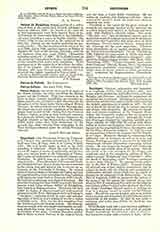

Peutinger, CONRAD, antiquarian and humanist, b. at Augsburg, October 14, 1465; d. December 28, 1547. As a young man he studied law and belles-lettres at Padua, Bologna, and Florence. At Rome his enthusiasm for antiquity was awakened. Returning to Germany he entered the service of his native city in 1490, receiving the definite appointment of syndic in 1497. To the end of his life he served the city in various capacities and always with distinction. He enjoyed the friend-ship and special confidence of the Emperor Maximilian, who frequently employed him on missions of a diplomatic or literary nature. Through this friend-ship Peutinger obtained for Augsburg valuable privileges, notably in 1506 while he stayed with Maximilian in Vienna and Hungary, where he took a leading part in the negotiations between the emperor and his rebellious Hungarian subjects. In 1512 he acted as intermediary between the emperor and the Republic of Venice. Moreover, through his connections with influential men in Germany, as well as in Italy and France, Peutinger was able to procure for his imperial friend much valuable information concerning current events. He was frequently occupied with furthering the literary and artistic plans of his patron; thus he had much to do with arranging for the designs and woodcuts used in the sumptuous editions of Maximilian‘s poems “Weisskunig” and “Teurdank”. After the death of Maximilian (1519) Peutinger continued to serve under Charles V. He represented his native city at the Diet of Worms (1521). Towards Luther his attitude was at first entirely sympathetic, but he refused to break with the Church, and maintained a conservative attitude which made him an object of distrust to the adherents of the Reformation. At the Diet of Augsburg (1530) he presented the protest in the name of the city against the imperial decree, but when, in 1534, it was proposed to carry out the religious innovations without regard to the desires of the Catholic clergy, Peutinger advised against it, putting his trust in a plenary council to restore the lost Church unity. His advice was not heeded, and so he retired with a pension and henceforth devoted himself almost exclusively to his studies. In 1538 he was made a patrician, and a few days before his death he was ennobled.
Of his literary work only a part has been published. In Augsburg he had collected a rich store of ancient Roman inscriptions, the historical value of which he had learned to realize while a student in Italy. At the suggestion of Maximilian these were published in 1505 under the title “Romance vetustatis fragmenta in Augusta Vindelicorum et ejus dicecesi” (2nded., 1520, Mainz). In the “Sermones convivales de finibus Germanise contra Gallos”, which goes under Peutinger’s name, the ancient boundaries of Gaul and Germany are discussed. Peutinger also published many important sources for German history, among them the history of the Goths by Jordanes, that of the Langobards by Paulus Diaconus, and the “Chronicon Urspergense” (see Konrad of Lichtenau), all of which appeared in 1515. The famous “Tabula Peutingeriana”, a thirteenth-century copy of an old Roman map of the military roads of the empire, is not properly called after Peutinger, to whom it was bequeathed by its discoverer, Conrad Celtes. Peutinger intended to publish it, but died before he could carry out his plan. Peutinger’s magnificent collection of MSS., coins, and inscriptions remained in his family until 1714, when the last descendant, Ignace Peutinger, bequeathed it to the Jesuits of Augsburg. After the suppression of the order, part of it went to the town library, and part to Vienna.
ARTHUR F. J. REMY

